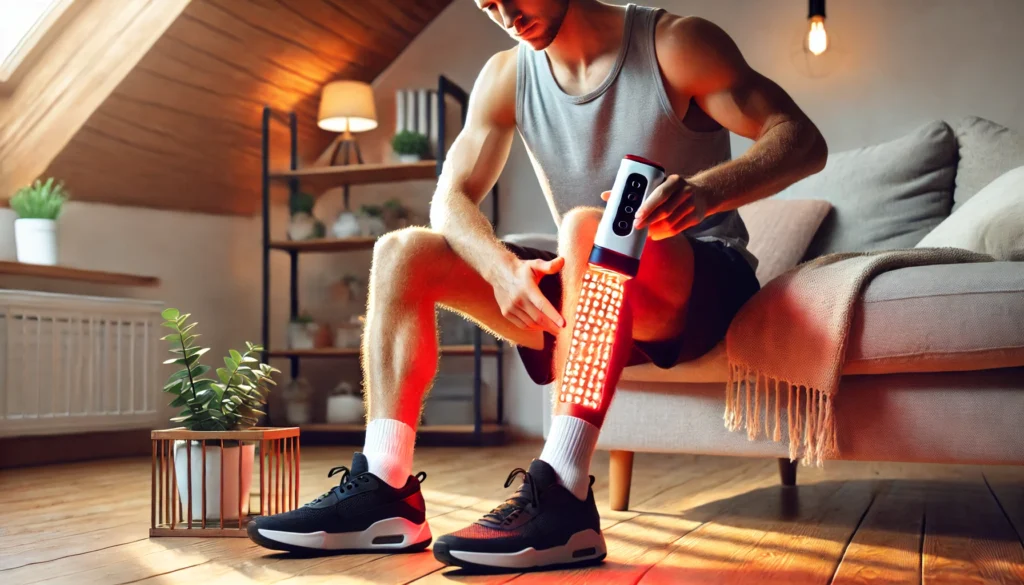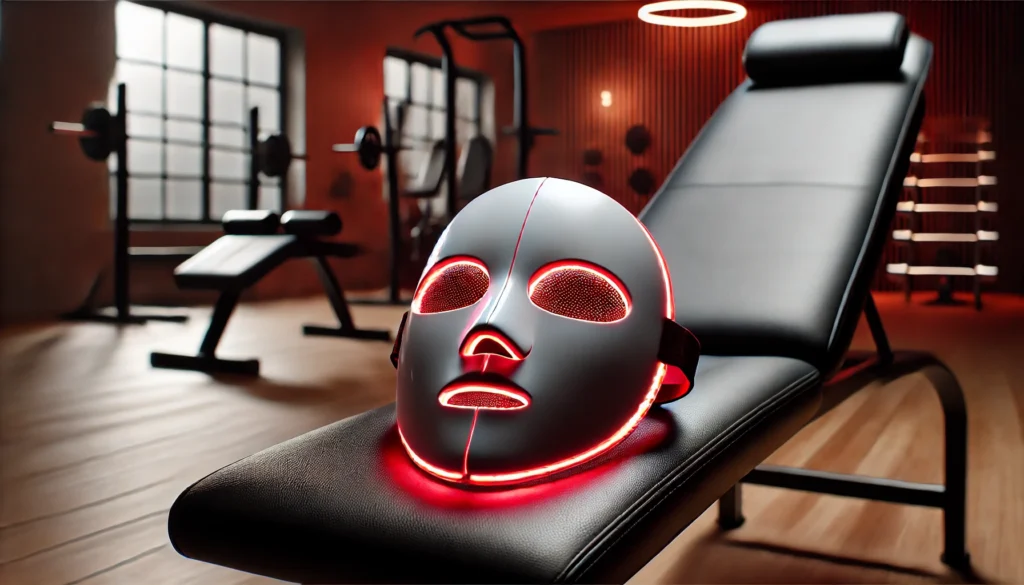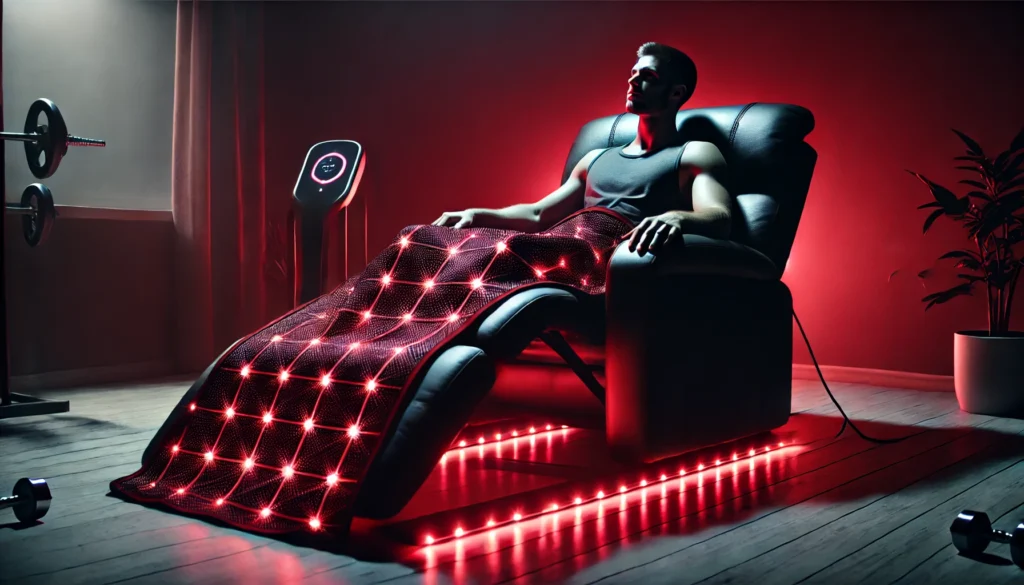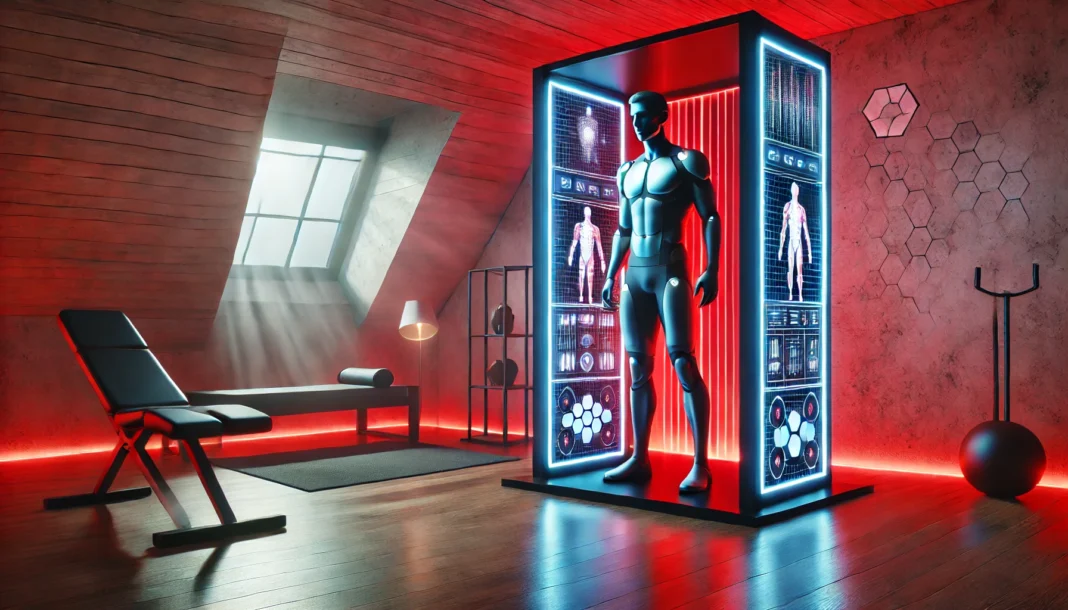The Science Behind LED Light Therapy for Muscle Recovery
Athletes are constantly searching for innovative ways to optimize their performance and accelerate recovery. One of the most promising advancements in recent years is the use of LED light therapy to enhance muscle recovery and reduce soreness. Traditionally used in dermatology for skin rejuvenation, LED light therapy has now found its place in the world of sports science, offering athletes a non-invasive method to recover faster and train harder.
You may also like: Red Light Therapy for Muscle Recovery: How Athletes Can Speed Healing and Enhance Performance
LED light therapy works by delivering specific wavelengths of light to the body’s tissues, stimulating cellular activity and increasing blood circulation. The most commonly used wavelengths in muscle recovery are red and near-infrared light, which penetrate deeply into the muscles and promote cellular repair. This process, known as photobiomodulation, enhances mitochondrial function, leading to increased energy production at the cellular level. As a result, muscle fatigue is reduced, inflammation is minimized, and overall recovery time is shortened. The best at-home LED light therapy devices allow athletes to harness these benefits in a convenient and accessible manner.
How LED Light Therapy Supports Muscle Regeneration
Muscle regeneration is a crucial aspect of athletic performance. After intense training sessions, microscopic damage occurs within the muscle fibers, leading to inflammation and soreness. While this process is a natural part of muscle growth, prolonged inflammation can hinder recovery and impact subsequent performance. LED light therapy plays a vital role in mitigating these effects by stimulating the production of adenosine triphosphate (ATP), the energy currency of cells. Increased ATP production accelerates tissue repair, allowing muscles to heal more efficiently.
Moreover, LED light therapy has been shown to enhance the synthesis of collagen and elastin, two essential proteins that contribute to muscle flexibility and structural integrity. This is particularly beneficial for athletes who engage in high-impact sports or strength training, as it reduces the risk of injuries such as muscle strains and tendonitis. The best red light therapy mask options on the market also offer targeted treatment for facial muscles, aiding in the reduction of tension and promoting overall relaxation.
Comparing At-Home LED Light Therapy to Traditional Recovery Methods
Traditional muscle recovery techniques, such as ice baths, massage therapy, and stretching, have long been used by athletes to alleviate soreness and improve flexibility. While these methods remain effective, they often require significant time and resources. In contrast, the best at-home LED light therapy devices provide a hassle-free solution that can be easily incorporated into daily routines. Unlike ice baths, which constrict blood vessels and slow the healing process, LED light therapy enhances circulation, ensuring a steady supply of oxygen and nutrients to the muscles.
Massage therapy, although beneficial for breaking down adhesions and improving mobility, can be costly and time-consuming. LED light therapy, on the other hand, offers similar benefits without the need for professional intervention. Furthermore, static stretching, while essential for maintaining flexibility, does not directly address inflammation or cellular repair. By integrating LED light therapy into their recovery regimen, athletes can experience a more comprehensive and efficient recovery process.
Choosing the Best At-Home LED Light Therapy Device for Recovery
With the growing popularity of LED light therapy, the market is flooded with various devices, making it essential for athletes to choose a high-quality product that meets their needs. The best at-home LED light therapy devices should feature multiple wavelength options, adjustable intensity settings, and FDA approval for safety and efficacy. Devices that incorporate near-infrared light are particularly advantageous, as they penetrate deeper into the muscles, providing enhanced therapeutic effects.
For athletes seeking facial recovery benefits, the best red light therapy mask can be an excellent addition to their routine. These masks are designed to deliver targeted treatment to the facial muscles, promoting relaxation and reducing signs of stress and fatigue. Meanwhile, those looking for a cost-effective solution may opt for the best affordable red light therapy mask, which offers similar benefits at a more accessible price point.

Practical Application of LED Light Therapy in Athletic Training
Incorporating LED light therapy into an athletic training regimen requires consistency and strategic application. For optimal results, athletes should use their chosen LED device immediately after workouts to enhance recovery. Sessions typically last between 10 to 20 minutes, depending on the device’s intensity and wavelength settings. Regular use, ideally at least five times per week, ensures sustained benefits and continuous muscle regeneration.
Additionally, combining LED light therapy with other recovery modalities, such as proper hydration, adequate nutrition, and sufficient rest, maximizes its effectiveness. Athletes should also pay attention to the placement of the device, ensuring that the light is evenly distributed across the targeted muscle groups. With the right approach, LED light therapy can become a cornerstone of any athlete’s recovery strategy, promoting long-term performance gains and injury prevention.
Frequently Asked Questions (FAQ) on At-Home LED Light Therapy for Athletes
1. How does LED light therapy impact mental recovery in athletes?
Beyond physical recovery, LED light therapy significantly contributes to mental well-being by promoting relaxation and reducing stress. The exposure to red and near-infrared light stimulates the release of serotonin and endorphins, which enhance mood and alleviate symptoms of mental fatigue. Athletes who incorporate the best at-home LED light therapy into their routines often experience improved sleep quality, which is crucial for cognitive function and emotional stability. Consistent use of LED therapy can help in managing the psychological stress associated with intense training, allowing athletes to remain mentally sharp and focused. By fostering a balance between physical and mental recovery, LED therapy becomes an indispensable tool in overall athletic performance.
2. What are the long-term benefits of using LED light therapy for muscle recovery?
Long-term use of LED light therapy has been shown to enhance muscle endurance and reduce the risk of chronic injuries. Regular exposure to red light wavelengths strengthens mitochondria, the powerhouse of cells, leading to sustained improvements in energy production and muscle repair efficiency. Athletes using the best red light therapy mask for facial muscle relaxation also report reduced tension and improved blood circulation, which supports overall recovery. Over time, the anti-inflammatory effects of LED therapy help minimize joint pain and stiffness, making it a valuable addition to any athlete’s long-term recovery strategy. Furthermore, by consistently incorporating LED light therapy, athletes can maintain higher performance levels while reducing downtime due to injuries.
3. How does LED light therapy compare to other popular recovery methods?
Unlike traditional recovery methods such as ice baths and compression therapy, LED light therapy enhances healing without causing discomfort or requiring additional effort. While ice baths can temporarily reduce inflammation by constricting blood vessels, they may also slow down the body’s natural healing process. In contrast, the best at-home LED light therapy promotes blood flow and accelerates tissue repair, making it a more efficient option. Compared to massage therapy, which can be costly and time-consuming, LED therapy offers a hands-free, consistent, and targeted approach. Additionally, the best affordable red light therapy mask provides a cost-effective alternative for those looking to integrate this advanced technology without breaking the bank.
4. Can LED light therapy improve athletic performance beyond recovery?
Yes, LED light therapy does more than just accelerate muscle recovery—it also enhances athletic performance by improving cellular energy production. Increased ATP synthesis supports greater endurance, allowing athletes to train harder and recover faster. Additionally, the best red light therapy mask is known to improve skin health, reducing breakouts and inflammation caused by excessive sweating during workouts. The improved circulation facilitated by LED light therapy also enhances oxygen delivery to muscles, helping athletes sustain peak performance levels for longer durations. As a result, consistent use of LED therapy not only shortens recovery times but also contributes to overall strength, stamina, and resilience.

5. Are there any risks associated with at-home LED light therapy?
When used as directed, the best at-home LED light therapy devices are considered safe with minimal risks. Unlike UV light, which can cause skin damage, red and near-infrared light do not produce harmful radiation. However, prolonged exposure at high intensities may cause mild skin irritation or eye discomfort, making it essential to follow manufacturer guidelines. Those with photosensitivity or certain medical conditions should consult a healthcare professional before starting LED therapy. By selecting FDA-approved devices and adhering to recommended usage guidelines, athletes can safely enjoy the benefits of LED therapy without adverse effects.
6. How soon can athletes expect to see results from LED light therapy?
The benefits of LED light therapy are often noticeable within a few sessions, though optimal results require consistent use over several weeks. Some athletes report reduced muscle soreness and increased relaxation after just one treatment with the best red light therapy mask. However, long-term improvements in muscle regeneration, reduced inflammation, and enhanced endurance typically manifest after regular use over four to six weeks. Factors such as training intensity, overall health, and frequency of LED therapy sessions influence the speed of results. Patience and consistency are key to maximizing the effectiveness of LED light therapy.
7. Can LED light therapy be combined with other recovery techniques?
Absolutely. Integrating LED light therapy with other recovery techniques can further enhance its benefits. Many athletes pair the best at-home LED light therapy with foam rolling to break up muscle adhesions and increase flexibility. Hydration, proper nutrition, and sufficient sleep also play critical roles in maximizing recovery, and when combined with LED therapy, these elements create a holistic recovery plan. Additionally, those using the best affordable red light therapy mask for facial relaxation often incorporate mindfulness techniques to enhance mental clarity and stress relief. A well-rounded recovery regimen that includes LED therapy ensures comprehensive healing and peak performance.
8. What makes the best at-home LED light therapy devices stand out?
The best at-home LED light therapy devices distinguish themselves through features such as adjustable intensity settings, FDA approval, and the inclusion of both red and near-infrared light wavelengths. High-quality devices are designed with optimal wavelength penetration to ensure deeper tissue healing and maximum cellular stimulation. Portability and ease of use are also critical factors, allowing athletes to integrate LED therapy into their daily routines without inconvenience. The best affordable red light therapy mask provides a budget-friendly option without compromising on essential features, making this technology accessible to a wider audience. When selecting a device, athletes should prioritize safety, efficacy, and durability for long-term benefits.
9. Is LED light therapy effective for non-athletes or individuals with sedentary lifestyles?
Yes, LED light therapy is beneficial for anyone looking to improve muscle recovery, reduce inflammation, and enhance overall wellness. Non-athletes experiencing muscle stiffness from prolonged sitting or physical inactivity can also benefit from the best at-home LED light therapy devices. This technology supports circulation, alleviates joint pain, and promotes relaxation, making it a valuable tool for anyone seeking non-invasive wellness solutions. Additionally, the best red light therapy mask can help individuals combat signs of stress and fatigue, improving both physical and mental well-being. Whether used for athletic recovery or general health maintenance, LED therapy offers significant advantages for a wide range of individuals.
10. What does the future hold for LED light therapy in sports science?
As research on LED light therapy continues to expand, new advancements in wavelength optimization and device technology are expected to further enhance its effectiveness. Future developments may include AI-integrated devices that personalize treatments based on an athlete’s specific needs. The increasing availability of the best affordable red light therapy mask options suggests that this technology will become more accessible to both professional and amateur athletes. Moreover, ongoing studies are exploring the potential for LED therapy to accelerate healing from major sports injuries, which could revolutionize rehabilitation processes. As interest in non-invasive recovery methods grows, LED light therapy is poised to become a staple in athletic performance enhancement and general wellness.

Conclusion: The Future of Muscle Recovery with LED Light Therapy
As sports science continues to evolve, LED light therapy stands out as a revolutionary tool for muscle recovery. Its ability to enhance cellular function, reduce inflammation, and accelerate tissue repair makes it an invaluable addition to any athlete’s recovery toolkit. The best at-home LED light therapy devices provide a convenient and effective way to harness these benefits, enabling athletes to train smarter and recover faster.
Whether opting for a full-body panel, a targeted red light therapy mask, or a more budget-friendly option, athletes can find a device that suits their needs and enhances their recovery routine. By integrating this cutting-edge technology into their daily regimen, they can unlock new levels of performance and longevity in their athletic careers. The future of muscle recovery is here, and LED light therapy is leading the way.
muscle recovery, LED light therapy, red light therapy for athletes, sports recovery, at-home LED therapy, athletic performance, muscle regeneration, infrared light therapy, best red light therapy mask, best affordable red light therapy mask, photobiomodulation, performance enhancement, injury prevention, post-workout recovery, collagen production, athletic training, fitness recovery, pain relief therapy, endurance recovery, workout recovery methods.
Further Reading:
How Red Light Therapy Can Help an Athlete’s Body Recover
How Red Light Therapy Elevates Athletic Performance
Photobiomodulation in human muscle tissue: an advantage in sports performance?
Disclaimer
The information contained in this article is provided for general informational purposes only and is not intended to serve as medical, legal, or professional advice. While NewsHealthWatch strives to present accurate, up-to-date, and reliable content, no warranty or guarantee, expressed or implied, is made regarding the completeness, accuracy, or adequacy of the information provided. Readers are strongly advised to seek the guidance of a qualified healthcare provider or other relevant professionals before acting on any information contained in this article. NewsHealthWatch, its authors, editors, and contributors expressly disclaim any liability for any damages, losses, or consequences arising directly or indirectly from the use, interpretation, or reliance on any information presented herein. The views and opinions expressed in this article are those of the author(s) and do not necessarily reflect the official policies or positions of NewsHealthWatch.

